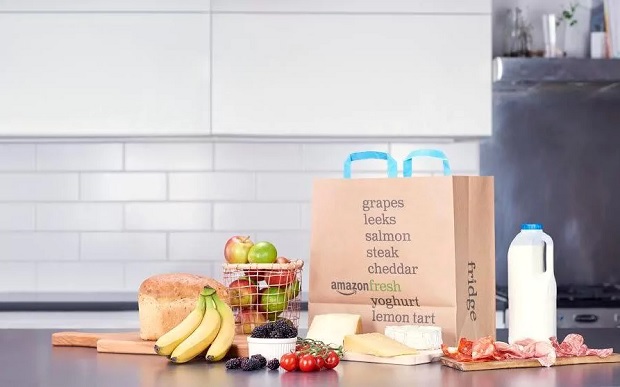Amazon is planning to open physical convenience stores as the online retail giant expands its push into the grocery market.
According to the WSJ, citing sources familiar with the matter, the small bricks-and-mortar stores would sell “produce, milk, meats and other perishable items” for customers to take home.
Customers would also be able order other items with longer shelf lives such as peanut butter and cereal via their phones or touchscreens in-store for same-day delivery.
According to the report, the stores will draw influence from discounters like Aldi and Lidl, with stripped-down stores, private-label brands and very few employees.
Amazon will also begin rolling out drive-in locations where online grocery orders will be brought to the car, with license plate reading technology to speed up waiting times.
The grocery stores will initially be exclusive for subscribers of Amazon Fresh, Amazon’s grocery delivery service which has been operating in the US for nine years and recently launched in the UK.
Analysis- focus on customer needs not channel
Hugh Fletcher, Digital Business Consultant at Salmon, said: “Amazon’s move to introduce further traditional bricks and mortar stores is a reminder that the high-street remains a vital component to the overall shopping experience – and that strong retail experiences must remain omnichannel. As ever, Amazon’s focus is meeting consumer needs and offering a comprehensive range of services. It’s interesting to note that Amazon’s smaller grocery stores will feature technology platforms that will allow users to deliver items from in-store to the home, while also choosing a specific time slot that suits their needs. As well as expanding Amazon Fresh, the online vendor is building on the impending drone delivery service, Amazon Dash, Echo and many other technologies. As consumers and retailers become further inter-connected by technology, retailers must embrace consumers’ craving for immediacy or face losing out to competitors, like Amazon, that do.
“Salmon’s own Programmatic Commerce study goes to show that consumers want a more personal experience that embraces technological devices: 57% of consumers agreed they will be ready for automated shopping through smart devices within 2 years. The research also shows that shoppers themselves see the great potential of technology in retail. Retailers now face the challenge of harnessing technology and catering to the modern day consumer who enjoys the convenience of online shopping and the traditional experience of physical stores. Amazon is clearly trying to do this and provide the technology-led service that consumers deserve.”
“Ultra-convenience” is key
Amazon, the nemesis of High Street stores everywhere, is abandoning its online-only model to open brick and mortar convenience stores. It’s a surprising move; but it makes commercial sense, argues e-commerce fulfilment expert ParcelHero’s Head of Consumer Research, David Jinks MILT. “Amazon is building on its Amazon Fresh grocery service to sell items such as fruit and veg, milk, meats and other perishables in town centre locations. The new stores will be aimed at Fresh customers who want to choose their own produce – a major drawback to online grocery shopping – or pick up their food on the way home from work.’
Explains David: ‘Amazon has already opened physical high street book stores, and pop-up shops highlighting its range of electronic goods. It’s move into physical food stores – reported first by the Wall Street Journal – reflects its concentration on winning a wider share of the grocery industry in the US and UK. American and British shoppers are rapidly moving their weekly food shop online; meaning the regular visit to the supermarket will soon be a memory – leaving many superstores as white elephants. In contrast convenience store sales will grow rapidly as consumers look to supplement their weekly food home deliveries with purchases of fresh items from handy local stores on the way home from work.’
The new Amazon convenience stores will be aimed at Fresh customers; who will probably use their mobiles to purchase items; possibly supplemented by touch screens around the stores. Drive in locations for online grocery pick-ups are also thought to be under development.
The first of Amazon’s ‘Project Como’ grocery stores is already reported to be under construction in Amazon’s home town of Seattle; and a clutch of other stores are expected to be opened over the coming year.
Predicts David: ‘Amazon has been quick to launch Fresh services in the UK and expand its range and options rapidly. There’s little doubt that it will also launch a physical presence in the UK if the experiment is well received in the US. In city centre locations fast service convenience stores make huge sense. The weekly food shop will soon be history in the US and the UK as Amazon Fresh, Ocado, etc take over this role. Super-fast service at small High Street stores, linked to Amazon Fresh checkouts on shoppers’ mobiles, make such stores ultra-convenient.’
Concludes David: ‘It’s yet more food for thought for the likes of Tesco; who must have thought at least their Metro sales were safe from the Amazon onslaught. If the experiment works out in the US; it’s a good bet we’ll see UK stores by the end of 2018.’
ParcelHero’s recent report on Amazon’s radical delivery plans – Amazon’s Prime Ambition – highlights a number of radical moves the e-commerce giant is making to become the pipe through which the majority of online sales flow.

